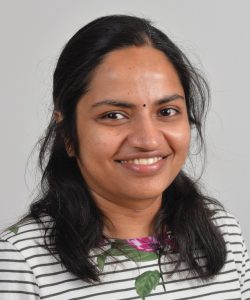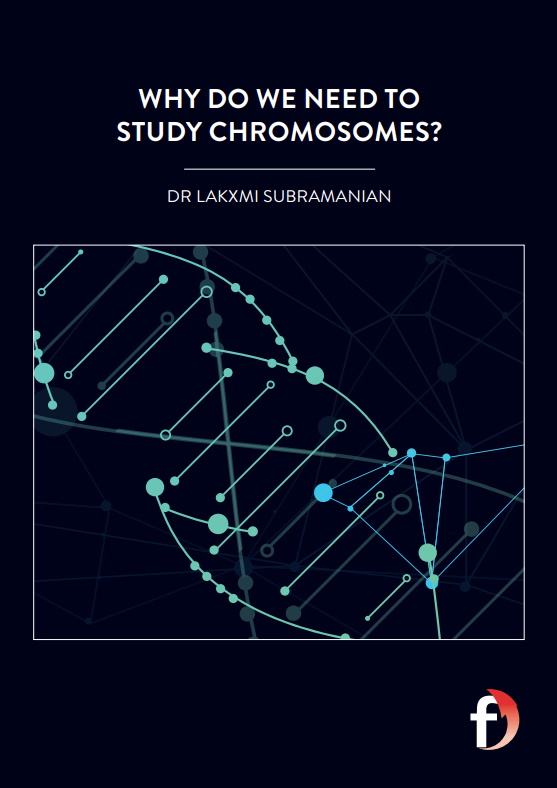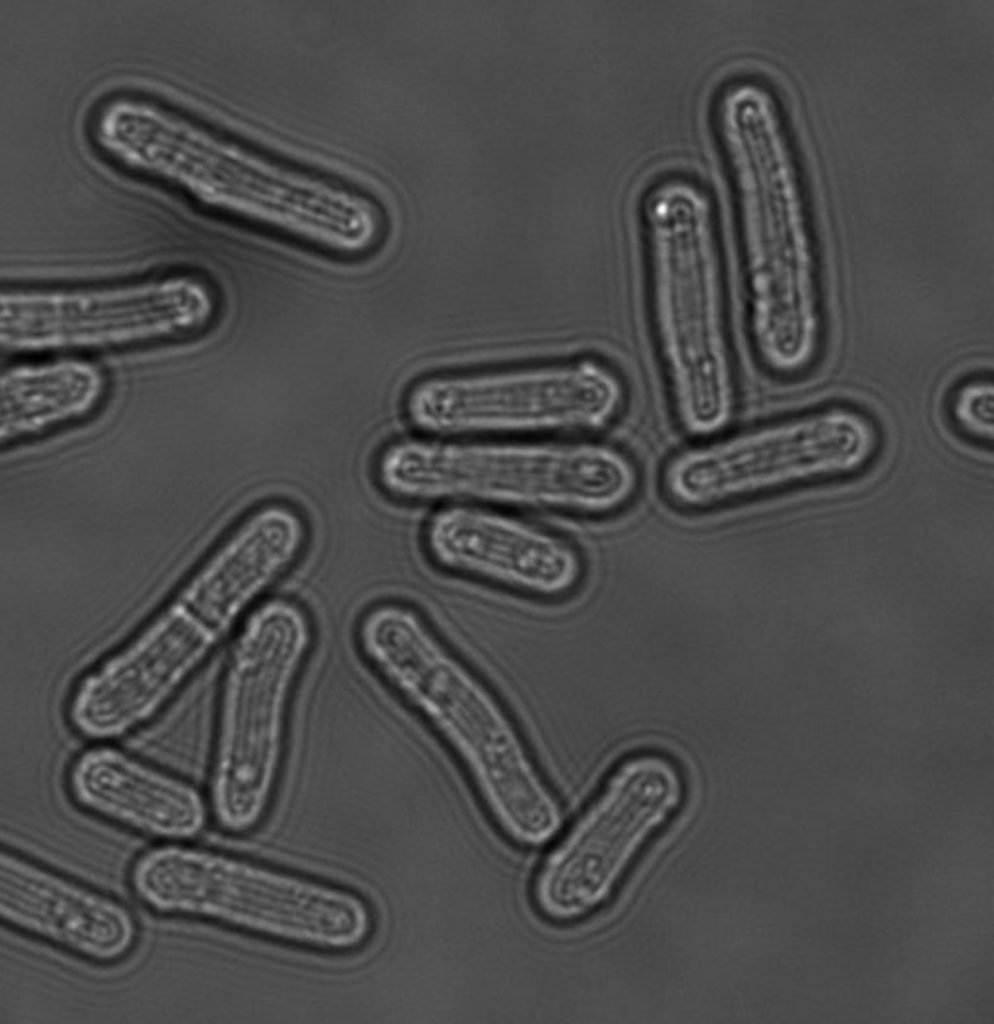Why do we need to study chromosomes?
Dr Lakxmi Subramanian, based at Queen Mary University of London in the UK, is investigating how chromosomes segregate during cell division. Her findings could lead to the development of effective treatment strategies against disorders caused by chromosome mis-segregation
Chromosomes are wonderful. They carry the genetic information that was passed from your mother and father to you and make you totally unique (unless you have identical siblings). The number of chromosomes that an organism has inside every cell is different for different species – mice have 40, giraffes have 62, chickens have 78 and cabbages have 18. Humans have 46 chromosomes which exist as 23 pairs – 22 of these are autosomes, while the other pair are sex chromosomes, also known as the ‘X’ and ‘Y’ chromosome.
In order for humans to have 46 chromosomes, they must accurately segregate during cell division (mitosis and meiosis). If chromosomes mis-segregate, babies can be born with a different number of chromosomes – either more or less than 46 – which can have extreme consequences for growth and development. Down’s syndrome, for example, is when a baby is born with an extra copy of their 21st chromosome in some or all of their cells, meaning they have an extra chromosome.
TALK LIKE A BIOCHEMIST
CHROMOSOME
A threadlike structure of nucleic acids and protein that is found within the nucleus of most living cells. It carries genetic information in the form of genes.
CELL DIVISION
The process by which a parent cell divides into two or more daughter cells.
CHROMOSOME MIS-SEGREGATION
A term denoting instances where dividing cells generate daughter cells which contain an incorrect complement of chromosomes.
CENTROMERE
A region of DNA that is responsible for the movement of the replicated chromosomes into the two daughter cells during mitosis and meiosis.
KINETOCHORES
Large protein complexes that assemble at the centromere of a chromosome. They connect chromosomes to microtubules.
MEIOSIS
Where a single cell divides twice to produce four cells containing half the original amount of genetic information. For a more detailed explanation, go to Live Science: https://www.livescience.com/52489-meiosis.html
MICROTUBULES
Structures that are responsible for various kinds of movements in all eukaryotic cells.
MITOSIS
Where a single cell divides into two identical daughter cells.
Dr Lakxmi Subramanian, a biochemist based at Queen Mary University of London in the UK, is leading a project that is attempting to understand how chromosomes are accurately segregated during cell division.
WHY IS IT IMPORTANT TO UNDERSTAND THIS?
Chromosome mis-segregation can lead to a jumbling up of chromosomes, where the wrong pieces of the genome are stuck in the wrong place. As already mentioned, having more or less than 46 chromosomes – or having them in the wrong place – can lead to the development of a wide range of disorders and diseases. Cancer cells have been shown to display an increased potential for chromosome mis-segregation (also known as chromosomal instability), which leads to an acceleration in cancer progression. By understanding how chromosomes accurately segregate, Lakxmi hopes that effective treatments against disorders caused by chromosome mis-segregation can be developed.
WHAT SPECIFIC QUESTIONS IS LAKXMI HOPING TO ANSWER AND WHY?
One of the main questions Lakxmi wants to answer is ‘What dictates the formation of a centromere and how is it epigenetically inherited?’ Researchers have so far been unable to find an answer and Lakxmi established her own laboratory in 2017 to do just this. “Centromeres are unique regions on chromosomes that are essential for accurate chromosome segregation, yet there is no specific DNA sequence that can signal centromere formation or function,” explains Lakxmi. “Interestingly, despite this, centromeres are inherited from one generation to the next, even when they end up being displaced to locations different from normal (such as in case of neocentromeres).”
Lakxmi’s team hypothesises that rather than the DNA sequence, there are probably other features that are recognised by specific proteins that aid centromere function. These features and proteins are the focus of Lakxmi’s research.
HAVE THERE BEEN ANY KEY FINDINGS TO DATE?
The research is still in the early stages, with current members of Lakxmi’s group joining in 2018 or 2019. However, there have been some major findings already, which have mainly been about how the biochemical and structural nature of the Mis18 complex influences its centromere function. More recently, the team has discovered how another centromere protein – CENP-C – affects meiotic chromosome segregation in fission yeast, which probably does the same in humans.
WHAT IS THE ULTIMATE AIM BEHIND LAKXMI’S RESEARCH?
“Our long-term goal is to dissect the centromere and its regulatory proteins to the extent that we understand exactly how the process of chromosome segregation works across evolution,” explains Lakxmi. “This has important consequences for understanding how cell division works as a whole and therefore impacts various fields of biology and medicine.”
 DR LAKXMI SUBRAMANIAN
DR LAKXMI SUBRAMANIAN
Lecturer in Biochemistry, School of Biological and Chemical Sciences, Queen Mary University of London, UK
FIELD OF RESEARCH: Biochemistry
RESEARCH: Lakxmi leads a team trying to find out how chromosomes segregate during cell division. The findings could lead to the development of effective therapeutic strategies against disorders caused by chromosome mis-segregation
FUNDERS: UKRI and the Royal Society
Reference
https://doi.org/10.33424/FUTURUM67
In order for humans to have 46 chromosomes, they must accurately segregate during cell division (mitosis and meiosis). If chromosomes mis-segregate, babies can be born with a different number of chromosomes – either more or less than 46 – which can have extreme consequences for growth and development. Down’s syndrome, for example, is when a baby is born with an extra copy of their 21st chromosome in some or all of their cells, meaning they have an extra chromosome.
TALK LIKE A BIOCHEMIST
CHROMOSOME
A threadlike structure of nucleic acids and protein that is found within the nucleus of most living cells. It carries genetic information in the form of genes.
CELL DIVISION
The process by which a parent cell divides into two or more daughter cells.
CHROMOSOME MIS-SEGREGATION
A term denoting instances where dividing cells generate daughter cells which contain an incorrect complement of chromosomes.
CENTROMERE
A region of DNA that is responsible for the movement of the replicated chromosomes into the two daughter cells during mitosis and meiosis.
KINETOCHORES
Large protein complexes that assemble at the centromere of a chromosome. They connect chromosomes to microtubules.
MEIOSIS
Where a single cell divides twice to produce four cells containing half the original amount of genetic information. For a more detailed explanation, go to Live Science: https://www.livescience.com/52489-meiosis.html
MICROTUBULES
Structures that are responsible for various kinds of movements in all eukaryotic cells.
MITOSIS
Where a single cell divides into two identical daughter cells.
Dr Lakxmi Subramanian, a biochemist based at Queen Mary University of London in the UK, is leading a project that is attempting to understand how chromosomes are accurately segregated during cell division.
WHY IS IT IMPORTANT TO UNDERSTAND THIS?
Chromosome mis-segregation can lead to a jumbling up of chromosomes, where the wrong pieces of the genome are stuck in the wrong place. As already mentioned, having more or less than 46 chromosomes – or having them in the wrong place – can lead to the development of a wide range of disorders and diseases. Cancer cells have been shown to display an increased potential for chromosome mis-segregation (also known as chromosomal instability), which leads to an acceleration in cancer progression. By understanding how chromosomes accurately segregate, Lakxmi hopes that effective treatments against disorders caused by chromosome mis-segregation can be developed.
WHAT SPECIFIC QUESTIONS IS LAKXMI HOPING TO ANSWER AND WHY?
One of the main questions Lakxmi wants to answer is ‘What dictates the formation of a centromere and how is it epigenetically inherited?’ Researchers have so far been unable to find an answer and Lakxmi established her own laboratory in 2017 to do just this. “Centromeres are unique regions on chromosomes that are essential for accurate chromosome segregation, yet there is no specific DNA sequence that can signal centromere formation or function,” explains Lakxmi. “Interestingly, despite this, centromeres are inherited from one generation to the next, even when they end up being displaced to locations different from normal (such as in case of neocentromeres).”
Lakxmi’s team hypothesises that rather than the DNA sequence, there are probably other features that are recognised by specific proteins that aid centromere function. These features and proteins are the focus of Lakxmi’s research.
HAVE THERE BEEN ANY KEY FINDINGS TO DATE?
The research is still in the early stages, with current members of Lakxmi’s group joining in 2018 or 2019. However, there have been some major findings already, which have mainly been about how the biochemical and structural nature of the Mis18 complex influences its centromere function. More recently, the team has discovered how another centromere protein – CENP-C – affects meiotic chromosome segregation in fission yeast, which probably does the same in humans.
WHAT IS THE ULTIMATE AIM BEHIND LAKXMI’S RESEARCH?
“Our long-term goal is to dissect the centromere and its regulatory proteins to the extent that we understand exactly how the process of chromosome segregation works across evolution,” explains Lakxmi. “This has important consequences for understanding how cell division works as a whole and therefore impacts various fields of biology and medicine.”
 DR LAKXMI SUBRAMANIAN
DR LAKXMI SUBRAMANIAN
Lecturer in Biochemistry, School of Biological and Chemical Sciences, Queen Mary University of London, UK
FIELD OF RESEARCH: Biochemistry
RESEARCH: Lakxmi leads a team trying to find out how chromosomes segregate during cell division. The findings could lead to the development of effective therapeutic strategies against disorders caused by chromosome mis-segregation
FUNDERS: UKRI and the Royal Society
ABOUT BIOCHEMISTRY
Put simply, biochemistry is a combination of biology and chemistry and involves the study of the molecular basis for life. The term ‘biochemistry’ was coined in 1903 by a German chemist called Carl Neuber, although work in the field had begun many years before that. Indeed, modern biochemistry is the result of a field of science that was known as physiological chemistry in the nineteenth and early twentieth centuries.
WHY IS BIOCHEMISTRY IMPORTANT?
As Lakxmi’s research surely attests, biochemistry can help us solve many problems that will lead to improvements in treatments and the quality of life. However, scientific enquiry does not always have to have specific, tangible outcomes – finding out things and understanding more about the world is a positive outcome in and of itself. The breadth within biochemistry is truly staggering and extends beyond humans to analysis of food products, bacteria, viruses and other organisms. A list of all the benefits of biochemistry would be almost as long as the DNA in all your cells put together.
*This is probably an exaggeration, as that distance would be about twice the diameter of the Solar System! But it should help reinforce the idea that biochemistry is extremely important.
ARE THERE MANY OPPORTUNITIES IN BIOCHEMISTRY IN THE UK?
Yes, absolutely! One of the best things about a biochemistry degree is that it opens up a broad range of potential careers that combine biology, chemistry and medicine. The Prospects website lists several careers you could embark on after completing a biochemistry degree, includingpharmacologist, laboratory technician and forensic scientist.
You will also develop a wealth of specific skills associated with biochemistry, including the ability to assemble an argument and engage in debate, observation skills, critical thinking and problem-solving.
DOES QUEEN MARY UNIVERSITY OF LONDON HAVE ANY SPECIFIC OUTREACH ACTIVITIES RELATED TO BIOCHEMISTRY?
Yes, the university is actively engaged in loads of public outreach. “We host the Festival of Communities every summer where researchers from the School of Biological and Chemical Sciences, and the university as a whole, host fun science activities for children and young adults in the community,” says Lakxmi. “We also have the Centre of the Cell housed at the Blizard Institute, which hosts school students and teachers on a regular basis, offering interactive fun activities in its Neuron Pod. This is where school students get to learn about how cells in the human body work – through biochemical or related processes.”
• The Association for Clinical Biochemistry and Laboratory Medicine is a brilliant resource for those thinking about embarking on a career in clinical science.
• The Biochemical Society is encyclopaedic in its detail and its careers page is particularly useful for those looking to gain a qualification in biochemistry.
• Biochemists can earn anywhere between £26,500 to £60,000 per annum, depending on their level of experience.
Consider studying biology and chemistry at school and college. You will usually need a science degree. Relevant degree subjects include:
• BIOCHEMISTRY
• BIOTECHNOLOGY
• BIOPHARMACEUTICALS
• CHEMICAL AND MOLECULAR BIOLOGY
• GENETICS AND MOLECULAR BIOLOGY
• MICROBIOLOGY
HOW DID DR LAKXMI SUBRAMANIAN BECOME A BIOCHEMIST?
WHAT IS IT ABOUT BIOCHEMISTRY THAT YOU LOVE?
What I love about the molecular biosciences (which includes biochemistry, molecular biology and molecular genetics) is that they give researchers opportunities to get to the bottom of how things work in biology. We are able to uncover how specific molecules interact with each other in order to effect various processes in cells, tissues and ultimately, the whole organism.
DID YOU ALWAYS IMAGINE YOU WOULD BE A BIOCHEMIST/SCIENTIST WHEN YOU WERE YOUNGER?
When I was a child, I didn’t think I would be a scientist – although I always thought scientists were very cool! Ironically, I had no interest in biology, until I turned 15. As a young child, I was highly influenced by my dad – I always thought he knew everything (which he did!). I looked up to my dad as my role model and wanted to be an engineer like him, but always doubted whether I would indeed end up being like him, because he was a man, and I was just a girl – this feeling is not unique to me, but is something I identify with in girls growing up in patriarchal cultures across the world.
My dad was a chemical engineer from one of India’s best institutions (the Indian Institute of Technology Madras), and my mum was a musician. I was also my parents’ only child – so my parents always expected me to do well in my studies, and each wished I’d follow in their footsteps – for this reason, I actually took up training in Indian classical music for almost 10 years! As I grew up, though, my interests slowly began to solidify.
I always liked mathematics and the physical sciences, but what was funny is that if it weren’t for my dad’s various moves around India for work, I may have never known that I could even be interested in biology. I was fortunate enough to come across a fantastic biology teacher in high school, who I am thankful for to this day. By the time I graduated from school, I knew that I wanted to be a geneticist – so I chose an undergraduate programme that would provide me the foundation necessary for a research career in genetics, but at the same time leave me with an engineering/technology degree, at Anna University, Chennai, India – and the rest, as they say, is history.
HOW WOULD YOU DESCRIBE YOURSELF? ARE THESE TRAITS IMPORTANT IN A BIOCHEMIST OR SCIENTIST?
I would describe myself as a focused, tenacious and hard-working individual. One quality I like about myself is that I don’t give up on things easily – I persevere and persist, and this is a trait I’ve had ever since I was a child. At times, this has also worked against me, as I’ve held on to research projects that I should’ve perhaps given up on long before I did. I think it’s important for a scientist to have tenacity and perseverance because, as scientists, we spend most of our lives experimenting – and most results of experiments, believe it or not, are failures. One must have the drive and acumen to think about what could’ve gone wrong, and improve one’s experiments, until success is achieved. It’s important to not let failure faze you.
IF YOU COULD GO BACK IN TIME, WHAT ADVICE WOULD YOU GIVE TO YOUR YOUNGER SELF?
I would ask myself to take more breaks than I did! I completed my undergrad degree and, soon after, began my PhD at the University of Illinois at Chicago. I repeated the same when it came to roles I took up thereafter. In effect, the whole of my 20s and early 30s were spent with no substantial breaks, which I really wouldn’t recommend to any young adult. I think it’s healthy to take breaks – to rejuvenate one’s mind, and stay creative. If I could go back in time, I would make sure I went on vacations more often and travelled around the world.
LAKXMI’S TOP TIPS
1 If possible, try and identify the type of career you’d like to get into as early as you can, so you have enough time to plan your pathway.
2 Stay focused on your goal. It is useful to speak regularly with your family, friends, teachers and peers. Try and pick the brains of those with experience in your chosen career path, because you might discover a piece of advice that you will look back on as being critical to your future success.
3 The internet can be a wonderful tool for research – do background research wherever possible. You should also read up on people’s experiences in their chosen careers, whether that is personal blogs or websites such as Futurum Careers!
4 Work hard and, although it is often easier said than done, stay unfazed when circumstances around you appear to be adverse. It will teach you a lot about yourself, which can only be a good thing.









